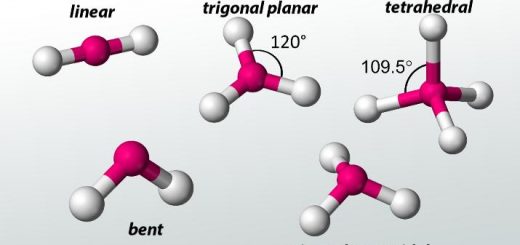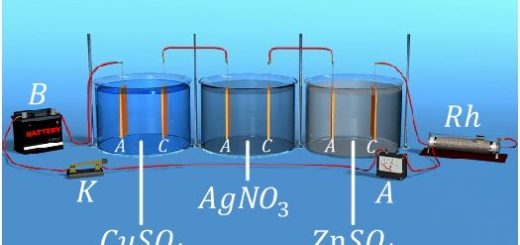Types of compounds, Properties of Acids, Bases (alkalis), Oxides and Salts
In nature, there is a countless number of existing compounds, Compounds can be classified according to their properties into acids, bases (alkalis), oxides and salts. Acids have an effect on litmus paper which is different from bases because acids change the colour of litmus paper into red, while bases change the colour of litmus paper into blue. You should not touch acids or even bases with your bare hands as they have a corrosive effect on the skin.
Acids
Acids are substances (materials) that dissociate in water producing positive hydrogen ions H+, The chemical formula for all mineral acids begins with hydrogen joined with:
- One of the negative atomic groups [ except (OH)− group], such as sulphuric acid (H2SO4) and nitric acid (HNO3).
- One of nonmetal elements [except oxygen], such as hydrochloric acid (HCl) and hydrobromic acid (HBr).
Properties of acids
Acids have a sour taste. they change the colour of blue litmus paper into red due to the presence of the positive hydrogen ions H+. Acids are classified according to their strength [ degree of ionization] into:
- Strong acids: such as hydrochloric acid (HCl) & nitric acid (HNO3).
- Weak acids: such as carbonic acid (H2CO3).
Bases
Bases are substances that dissociate in water producing negative hydroxide ions (OH)−, the chemical formula of all bases (alkalis) ends with (OH)− group. Examples of some bases: Sodium hydroxide [caustic soda] (NaOH), Potassium hydroxide (KOH) and Calcium hydroxide [limewater] (Ca(OH)2).
Properties of bases (alkalis)
Bases change the colour of red litmus paper into blue due to the presence of the negative hydroxide ions (OH)−, Their aqueous solutions have a bitter taste and feel slippery. If you have two unmarked tubes, one contains acid and the other contains a base. How can you distinguish between them?
By putting two litmus papers (red and blue) in each tube, If the colour of the litmus paper changes into red, the tube contains the acid, If the colour of the red litmus paper changes into blue, the tube contains the base.
Oxides
Oxides are compounds that result from the combination of oxygen and an element even though it is a metal or a nonmetal. oxides are classified into metal oxides and nonmetal oxides.
- Metal oxides are formed from the combination of oxygen with a metal. such as sodium oxide (Na2O) and aluminium oxide (Al2O3).
- Nonmetal oxides are formed from the combination of oxygen with a nonmetal. such as Carbon dioxide (CO2) and Sulphur trioxide (SO3).
Salts
Salts exist within the components of the Earth’s crust or dissolved in the water of seas and oceans. Salts are compounds resulted from the combination of a positive metal ion (or a positive atomic group) with a negative atomic group (or a negative nonmetal ion except oxygen).
All of the negative ions from salts except the negative oxygen ion (oxide O−−). All of negative atomic groups from salts except the hydroxide group (OH−). Salts are produced from the combination of:
- A positive metal ion with negative nonmetal ion, such as sodium chloride [table salt] NaCl, and Lead bromine PbBr2.
- A positive metal ion with a negative atomic group, such as sodium nitrate NaNO3, and Anhydrous copper sulphate CuSO4.
- A positive atomic group with negative nonmetal ion, such as ammonium chloride NH4Cl, and ammonium bromide NH4Br.
- A positive atomic group with a negative atomic group, such as ammonium carbonate (NH4)2CO3, and ammonium nitrate NH4NO3.
Properties of salts
Salts are variant in some of their properties such as taste, colour, smell. solubility in water and others. Salts differ according to the solubility in water into:
- Salts dissolve (soluble) in water, such as sodium chloride (NaCl), potassium sulphate (K2SO4), Calcium nitrate (Ca(NO3)2), and Sodium sulphide (Na2S).
- Salts do not dissolve (insoluble) in water. such as silver chloride (AgCl), lead iodide (PbI2) and lead sulphate (PbSO4).
All of carbonate salts don’t dissolve in water except sodium carbonate, potassium carbonate and ammonium carbonate. We can obtain sodium chloride (NaCl) solution and not silver chloride (AgCl) solution because sodium chloride is a water-soluble salt, while silver chloride is water-insoluble salt.
All acids turn colour of litmus into red and having a sour taste, while all bases turn the colour of litmus into blue with a bitter taste because acids, when dissolved in water, produce positive hydrogen ions H+ which responsible for their properties, while bases, when dissolved in water, produce negative hydroxide ions (OH)− which responsible for their properties.
Caustic soda is from bases, while lead bromide is from salts because caustic soda contains negative hydroxide ion, while lead bromide is formed from the combination of a positive metal ion with negative nonmetal ion.
Classification of Acids according to its strength (degree of ionization), Its source & Basicity
Classifications of bases according to strength ( degree of ionization ) and molecular structure
Properties of Acids and Bases & Theories defining acids and bases
Economic importance of some common acids, bases and salts (minerals)
Salts formation methods & types of aqueous solutions of salts
Salts formation, The chemical formula of salts and its naming



